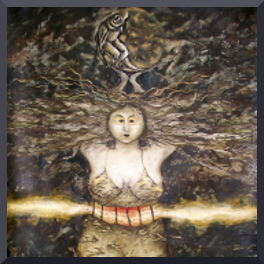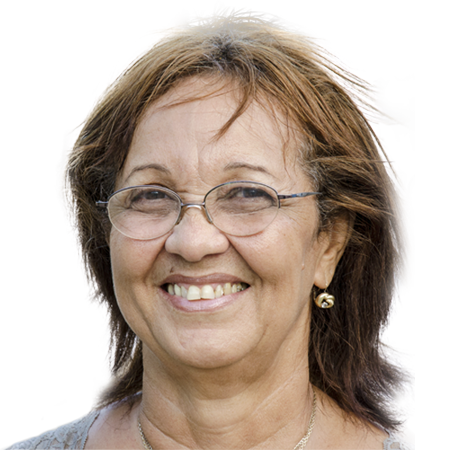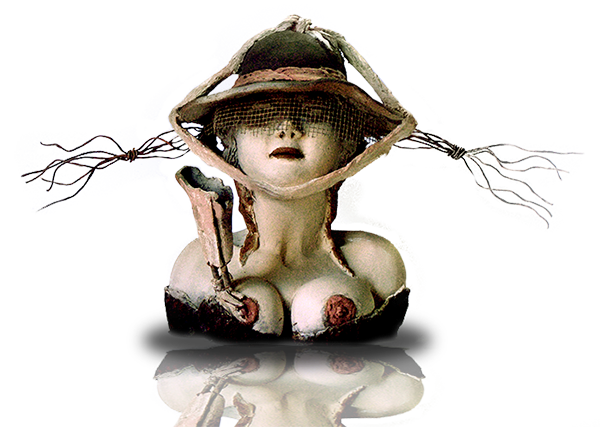

The feminine and the migratory problem in the contemporary painting of Martha Jimenez
Migration is an inherent process in the development of humanity. With regard to our continent, we can say that the Americas received throughout the fifteenth and sixteenth centuries one of the greatest migratory waves of our era. This process of assimilation of immigrants gradually shaped our nationalities due to the strong mixtures that took place in our territories.
In Cuba, specifically, it is in the early 90's that for extra-artistic reasons, the theme of migration adquires a major highlight. This was due to the fall of the socialist field and the tensions between the US and Cuban governments, as well as the desire of some Cubans to go after the "American dream." The difficult economic situation -among other things- caused the separation and uprooting of many families in our country. The sea constituted from those moments an escape route, but also a risk for the life of many persons. Faced with this phenomenon that affected and still affects a large part of Cuban society, the officers decided to remain silent and it was art that, from an ethical and dignified position, served as a spokesperson to argue and question the consequences -largely negative- of these facts. That is why throughout these two decades of the late twentieth and early twenty-first century, migration has been consummated as an important subject for Cuban culture, because today is part of one of the topics most addressed in current Cuban art.
Varieties have been the ways of seeing the migratory phenomenon in Cuban artists. One of them, is the creative Martha Jimenez who has raised from her Camaguey a speech loaded with subtlety. She has worked throughout her artistic career three major themes: The feminine-erotic-divine, the insularity-migration and the ironic-satirical. These are interwoven creating a rich thematic and conceptual complexity, which implies that when it is desired to investigate one of these categories, would necessarily have to resort to other aspects. So when researching on the subject of migration in Martha Jimenez's painting, we must do it from her perspective as a woman, because she uses it as a resource through which it expresses her concerns and hopes. She assumes thus, to the feminine sort, like entity, in which converge the utopias and dystopias of the Cuban of the XXI century.
It is worth mentioning that for the artist the migratory process is not only the fact of leaving the country -united to everything that this brought with it- but Martha has also made it clear that our physiognomy has been the successful result of a great ethnic mix, which is represented by her sensual, thick, mestizo, mulatto women, who proudly display their eroticized curves and breasts. Without departing from the current questions, she outlines a series of images where the Cuban lady is then in the position of emigrant and is when she charges, towards a possible distant destination, with her customs, habits, regrets and utopias.
In Martha Jimenez there is not only one result of immigration but a second part of the phenomenon, where it is the woman that questions and moves, with all that implies her spiritual and material world -in spite of the epochal distance to which she refers. Thus we will find their women traveling with a series of pots, stools and royal palms, all that means for Cuba its heritage and its tradition, in addition to what for the creator herself constitute her material goods. The artist frequently resorts to locate on the island of Cuba, the woman, mounted on a stroller or skateboard marching with the land to other places. She also uses the wheels as a symbol of translation and travel, in addition to alluding to the tropicality of Cuban fruit. She uses a great variety of symbols that connotan trip, transit, migration; such as the wheels, the cardinal points, the fish, the wings and the boats.
She applies in her works artistic patterns employed by avant-garde tendencies such as Surrealism and Expressionism. However, the forms in which these influences melt in the same work, transmit to the viewer the delicacy and subtlety with which she faces a fact that has generated many conflicts and that only she since the woman has known how to sweeten, without ceasing to touch the neuralgic points of the matter. We can even find the naked woman on a bird carrying with her in the beak of the animal a little man, with the sensuality that characterizes her brush, draws both fish with wings and legs, transformations that lead to think of everything that for her is valuable and essential. Although always dwarfed, the man in his role of companion, occupies a secondary place in front of the woman. And so Martha lets us know when, from the lady, she questions us and magnifies her, starring each scene.
Adrift, is one of the most attractive works of the series Women that fly, as the creative has turned her delicate and sweet line into a broken line of earthy colors and rough texture, almost monochromatic. She ties the woman's leg from the moon, which she lets herself be carried in a stroller on her island, in the arms they support the sun, symbol of all their dreams and utopias. In their backs they inhabit small wings besides the cardinal points that point to the south, our South. While man alone is an accessory that is included minimized in his transportation.
Battle is another of the works where women are forced to fight and overcome social and sexual prejudices. A lady in a first large plane, holding her arms up to the sky, a bubble, with a small fish with wings and legs, in a resting position. She has thus transformed man, making him an animal with all the skills to get where he wants, yet she encloses him, embroiders and holds him. Thus, she makes them mutant beings that in turn are men, birds, and fish. She envelops us in a surreal world with very expressive traits. Her black dress appears decorated with them, symbolizing, in dark tones, all the barriers she has had to face. She also has a belt of fire that imprisons her, in front of which she fights, against which she also rebels. She unites with these cold and dark colors all the contained sexuality that once occupied the place of feminine intelligence, now more than the body prevails a sensuality, which goes against all the patterns established by the centers of power, an avid thought of knowledge and an enormous desire to build their own world.
The sea and the fish will form an integral part of her works, in this way, either as a background or as a protagonist element, the sea will be involved making a subtle allusion to our status as islanders. Whether the sea or the air as the only ways we can contact the outside, important points when analyzing the works of Martha.
The insularity of Cuba, surrounded by sea completely, makes us people that we know isolated from the world, forced to fly or to swim to move us. That is why it is so necessary, today, to recognize ourselves as emigrants and immigrants -perhaps only as travelers- since the need to know other cultures, other customs, obliges us to do so.
Sofia is one of the pieces where the protagonist has wings decorated with fish from which they hang a balance, a stool, a boat with its anchor and a staircase. Sofia is suspended in the air and flies with all her patrimony to another place. I think of the woman as a missionary who constantly seeks her place, there, where are valid her opinions, her rights, that's where she must stay, where she can make her hopes come true.
The presence of the island of Cuba is one of the most significant elements of the pieces. This is worked on the basis of the same patterns with which she builds the plump woman, signs that alert us to the indissoluble unity between gender and space. In this way, our protagonist tries to fly, with small wings and on an island towards the moon, to this end, not only with barriers of prejudice and not so impassable, but with the sun that holds between her arms imprisoning the light and the hopes, symbol of her dreamlike universe and at the same time real.
The boat, is another of the symbols most used by the author, previously stranded at sea, (Obstacle) ready to sail with its lady, now it is the woman who on a big boat, sew on his machine, little boats, pieces he titled, The longing of my mother. Is it the sentiment of this lady, what our artist wants to convey to us, are her losses, her absences in this solitude in the middle of the sea, or she decided from her perspective, build her own world? Perhaps it means, this ship, to make her own journey, her own life, rather than abandon a physical place, refers to a spiritual place, this one, which she has occupied in centuries of existence and that it becomes necessary to change. By being alone and preparing her own resources, we could think of the independence of women, not as only being important but as a human being full of courage to face life without intimidation.
This migration, which for many means distance, perhaps and also symbolizes the encounter with ourselves. Migration that transits to another level, where the woman not only at a certain moment suffers the absence of her own, but she is the one who decides to face life without fears or underestimations. Migrating to Martha Jimenez contains in itself another theme, that of insularity, united with that constant search for identity, which in turn implies our geographical boundaries, a clear reference to our political and ideological sphere. The island is also a symbol of unity of differences of thoughts and postures from the ethical, sexual and ethnic order. These themes have become for the artist in pretexts for a deep defense of the woman from the woman.
Por: Lic. Leydis Izaguirre Jerez.




